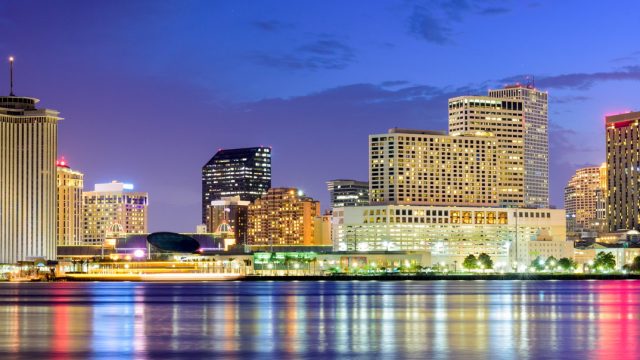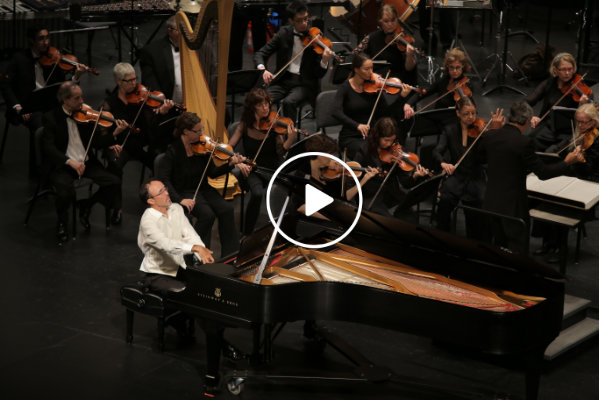
Video of the premiere is here on YouTube
Score for Currents is here on issuu.com
Currents is an emotional piano concerto that celebrates the diversity of the Mississippi River, rages at the failures of the levees after Hurricane Katrina, and expresses the pain, hope, and rebirth of the aftermath. It was commissioned by Dr. Rinna Saun.
Evocative, celebratory, lyric, at times violent and tragic, “Currents” is a moving, personal reflection of the composer’s hometown of New Orleans which includes a reaction to the tragedy that Hurricane Katrina wrought. The passing references to jazz fit in the fabric of this approachable, contemporary work beautifully. The writing for solo piano and orchestra is masterful and packs a powerful emotional punch.
Maestro Peter Bay
Austin Symphony, Hot Springs Music Festival, Arizona Philharmonic, conductor on premier of CurrentsAfter learning and performing this unique piano concerto, I believe that it needs to be heard by a wider audience, due to its incredible drama, story line, and orchestration that captivates the audience from the beginning to the end. It is a wonderful addition to the piano concerto repertoire!
James D’León
Steinway Artist, soloist on premier of CurrentsThe work is, in my opinion, a substantial contribution to the genre of concertante works for piano and orchestra. Its lineage is clear, and builds upon lyrico-dramatic works of the American tradition, while also adding its own distinct voice to it. Part of this comes from the expressive urgency that lies behind the work, a personal response to the tragic events surrounding Hurricane Katrina in New Orleans. But the distinctness of the work comes too from the finely wrought orchestral craftsmanship and the rich colouristic form, coming wave upon wave. The piano creates the waves, but also rides them melodically, while the final movement’s pulling away to a place beyond turbulence is both moving and sonically original.
Currents is a very fine work, and deserves to enter the repertoire; I highly recommend it to you.
Michael Zev Gordon
UK Composer, British Composer Awards, Prix Italia
The premiere of concerto was on August 26, 2018, with Maestro Peter Bay conducting the Arizona Philharmonic and Steinway Artist James D’León at the piano.
Program Notes
Dr. Rinna Saun and Henry Flurry met and became longstanding friends during high school, when they attended New Orleans Center for Creative Arts together. Through the ensuing years they discussed collaborating professionally and, in 2014, conceived the idea of Flurry writing a piano concerto for Saun to perform in 2016-2017. With 2015 being the 10th anniversary of Hurricane Katrina, it is not surprising that they settled on the idea of using New Orleans’ complex relationship with water as a starting point for the concerto.
While much of southern Louisiana is dominated by swamp land, within the city of New Orleans three waters impact daily life: the ever flowing and powerful Mississippi River that borders one side of New Orleans, the Lake Ponchartrain that borders the northern side and hides its far shores over the horizon, and the seemingly still waters (bayous and canals) that cut through the city. Combined, these waters enable industry, tourism, recreation — and sometimes tragedy.
The piano concerto is entitled “Currents.” Its three movements are subtitled “River,” “Breaking,” and “Still.”
I. River: The Mississippi River is the life blood of New Orleans. It created the land upon which New Orleans sits, it provides the drinking water for its residents, and it is a primary travel and shipping channel that makes New Orleans a major world port. If anything is constant about the river, it is that it is never stops moving and it brings continually changing sights and sounds.
II. Breaking: As Hurricane Katrina passed by New Orleans, storm surges pushed water from the river and lake into the canals that cross the city. While the rising water overtopped some levees, it was the seven catastrophic levee failures within the city that overwhelmed the city’s pumping stations and prevented New Orleans from completely draining the floodwaters for nearly a month. Although the levees were designed to resist water at levels much higher than those Katrina pushed into the city, the Army Corps of Engineers eventually conceded that the levees were never built nor maintained to those design specifications. Tests that demonstrated the appropriate design strength were either misinterpreted or ignored, money was pinched, and many fingers were pointed in the flooding’s aftermath. As it turns out, the 2005 New Orleans flood was not a natural disaster: it was a man-made disaster that killed a thousand or more New Orleans residents and cost over $100 billion.
The second movement is not about the tragedy and pain of the flood, as originally intended. It is more an expression of the anger that grows with awareness of the extent that human decisions — whether by error, apathy, or intentional malfeasance — played a role in this disaster. The time line of events between when Hurricane Katrina, still far offshore, was declared a Category 4 Hurricane (shortly after midnight on August 28, 2005) and martial law was declared in New Orleans (midday on August 30, 2005) provided a rough map for the movement. Of note are the seven full orchestral hits near the middle of the work that symbolically represent the seven levee breaches that occurred the morning of August 29.
III. Still: Still waters can be peaceful and reflective of the surrounding beauty, or, as in the case of the standing waters left after the levee failures, they can bring great sorrow and dramatically alter the future of a city and her people. This movement reflects that dichotomy by combining elements of pain and loneliness with beauty and hope. The piece is constructed from distorted fragments of the hymn “Nearer My God to Thee,” a hymn particularly relevant to New Orleans for its prominence in jazz funerals. Near the end of the work, the hymn comes together with the full orchestra, symbolizing both the way the entire city of New Orleans united to rebuild after the 2005 New Orleans flood and the hope that all who have lived in New Orleans have for that city.
